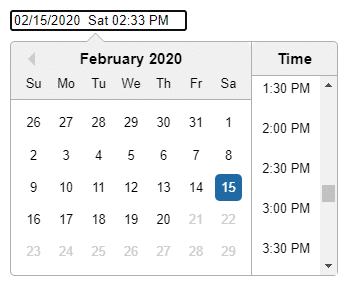

The last thing you need to do is to update the "defaultDate" variable when the user selects a new date in the picker's calendar (so that the variable reflects what the date picker is showing, and incrementing / decrementing the date will produce the correct result): DatePicker1.OnChange: Set(defaultDate, DatePicker1. The last thing you need to do is to update the "defaultDate" variable when the user selects a new date in the picker's calendar (so that the variable reflects what the date picker is showing, and incrementing / decrementing the date will produce the correct result): DatePicker1.OnChange: Set(defaultDate, DatePicker1.SelectedDate) In the date picker, you then set its Default property to the "defaultDate" variable, so that when that property is changed (by clicking the previous/next buttons), then the date displayed in the picker will be changed as well. Now you can add the two buttons (prev/next) and set their properties to update the value of that property: Button1.Text: "Previous day"īutton1.OnSelect: Set(defaultDate, DateAdd(defaultDate, -1, Days))īutton2.Text: Set(defaultDate, DateAdd(defaultDate, 1, Days)) In the app's OnStart property (you can find it on the first screen of your app), you'd need to initialize that value. Import "react-datepicker/dist/react-datepicker.You can use a global variable to store the date that is bound to the Default property in the date picker, and in the prev/next buttons you'd decrement/increment the variable value. Import DatePicker from "react-datepicker" So if you’re reading this at a later date, and the next version of Material UI is already stable then you should use that instead: import React, from "react" It is no longer supported (about a month ago from the time of writing this article).

#Setdate datepicker code
Note that this is the code for the current stable version of Material UI.
#Setdate datepicker install
The datetime picker doesn’t come with the core Material UI library so you’ll have to install it with the following command: npm install date-fns ^1.3.13 -save The only downside with this library is that it doesn’t have its own date range picker (on the stable release at least). The examples in the official documentation use date-fns as the datetime library for parsing and formatting dates but you can certainly use the datetime library of your choice. The datetime picker doesn’t come with the core Material UI library so you’ll have to install it with the following command: npm install material-ui/core date-fns date-io/email protected1.3.13 material-ui/pickers -save You can then use it like so. This makes it very easy to pick the time in both desktop and mobile views. Also, if you want to set this variable again on some action, you can use the same expression. Set (SelectedDatevar,If (AB,Today (),Blank ())) Now, you can reference this variable in the 'Default' property of your DatePicker.

This is the only component in this list that has a clock view. You can create a variable either on App Start or Page 'On Visible' property to check the condition and set the value.

You can customize the styles via the createMuiTheme() function provided by Material UI. The good thing about this library is that even though you’re constrained with Material Design, it is still very customizable. If you’re using Material UI as the base for the UI components of your project, you will most likely have to use Material UI’s date and time picker as well. Below are examples which also can be edited directly via the editor on the left side and will be rendered on the right. By default, the datepicker calendar opens in a small overlay when the associated text field gains. You can customize the date format and language, restrict the selectable date ranges and add in buttons and other navigation options easily. Or by using Yarn: yarn add react-datepicker. The jQuery UI Datepicker is a highly configurable plugin that adds datepicker functionality to your pages. The package can be installed via NPM: npm install react-datepicker -save. This is to ensure it will work on your project without going through a lot of hoops. A simple and reusable datepicker component for React. Note that we’ll only be going through the libraries which have been updated recently. In this post, I’ll walk you through some of the date picker libraries that I found really useful. With frontend frameworks like React, it’s easier than ever to share common functionality for different projects. That’s why libraries are created so that we don’t get stuck implementing the same thing over and over again. Top React date pickers for 2021Īs developers, we always look for ways to save time on our projects. Wern Ancheta Follow Fullstack developer, fitness enthusiast, skill toy hobbyist.


 0 kommentar(er)
0 kommentar(er)
